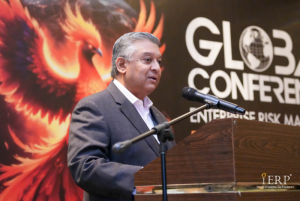@ the IERP® Global Conference, August 2023
Chaired by Max Lee, CEO and Co-Founder of Pantas, this session was about how addressing ESG-related issues could increase competitiveness and business opportunities, and how governance was crucial to risk-appropriate response plans and ensuring ESG principles were aligned throughout third-party networks. “In a world of rapidly changing environmental regulations and standards, how can a company ensure that their third-party ecosystem remains agile and adaptable?” Lee queried in his overview. Panellists for the session were Dr Darian McBain, former Head of Sustainability, Monetary Authority of Singapore; Mahidon Promwichit, ESG and Sustainability Lead, AmGeneral Insurance.
Ensuring an agile, adaptable third-party ecosystem would mean having a diversified supply chain, but this is easier said than done; how could organisations have a diversified supply chain that complies with all risk management and other requirements? Lee said that utilising technology was one way; so was third-party audits, as well as education and training for suppliers so that they could understand the importance of ESG, and integrate it into their business practices. For suppliers, it was about how to manage additional risk. “Risk management is not supposed to be in a silo,” he said. “A lot of companies realise that to create a resilient supply chain, they have to provide training for their suppliers.”
One of the outcomes of this was the development of insetting (as opposed to offsetting), where instead of buying carbon credits to offset emissions, companies incentivised their suppliers to reduce carbon emissions. Stating that scenario planning will be a regulatory requirement by 2025, Lee urged companies to implement third-party audits and certification. “Start early and plan for the risk,” he said, pointing out that this was one way the company could ensure it was agile and adaptable. On the benefits of collaboration, Dr McBain cited an instance where her company worked with suppliers to get better visibility of the supply chain, on-board fishing vessels.
What they looked at in particular was illegal fishing and human rights violations aboard vessels using electronic monitoring systems on boats to collect ESG data, she said. This was expensive and time-consuming but the company got to know its supply chain very well. “Because of this, we were able to continue supplying tuna to the US even during the pandemic,” she said, as these measures complied with regulations pertaining to US forced labour requirements. Given that there is a gap between companies’ stated goals and what is needed from third-party compliance, what measures should firms prioritise, Lee asked.
“Some targets are not practical,” Mahidon pointed out. “What is important is that you communicate if you are not on track to hit your targets.” Affirming that companies wanting to transition to net zero will see their emissions increasing, he said, however, that by setting targets, the organisation was indicating its aspirations to hit targets, which was a good thing. “If it happens to go up, you have to disclose why it has gone up, and take the necessary measures to mitigate it,” he said, adding that not setting targets was worse than setting targets and not hitting them, because “By not setting targets, it means you are not going to do anything.”
Organisations, he said, had a responsibility to help third-party suppliers or partners to transition. Engagement, collaboration, training, creating awareness, and communicating specific ESG objectives clearly were all critical factors that could help successful transition. “They will not be able to do it on their own,” he said. “It will not be fair to penalise them.” Instead, he suggested bringing them into the ecosystem, adding that some financial institutions had already instituted measures such as helping their lending customers record their emissions. “It’s about us, as an organisation, communicating our targets and helping them to transition,” he said.
To a remark by Lee about increasing efficiencies contributing to increases in the cost of the produce, Dr McBain said that there was a cost to everything, including the cost of measuring and the time used to collect data. Methods were now being developed where workers who have the data would be allowed to sell it to customers who want it. “This is a way of putting a price on data in the future,” she said. “People will start seeing that there is value to the data.” On the issue of human rights abuse within the supply chain, Lee asked what steps companies could take when faced with allegations like these.
“You do need to have the data,” Dr McBain stressed. “If you make unqualified statements without having the data, that is greenwashing. You need to speak to people along the supply chain, develop a check list…maybe even take a “snapshot in time” – send someone to the site of the allegation to investigate.” The organisation then has to decide on a course of action. She cautioned that different countries have different regulations; there were also cultural sensitivities to consider, as in some countries, children may work with their families instead of going to school, or may work after school. It may be difficult to determine if the issue was a ‘black or white’ case of child labour.
On the role of technology and innovation in enhancing transparency, accuracy and effectiveness of human rights assessments, she said that there was some work being done with satellite imagery that was producing results. Usually applied in deforestation issues, this new technology was now being utilised to track habitation and migration, which are two important human rights factors. She emphasised that having images and records was especially useful when doing analysis. Third-party ecosystems are expanding and becoming more intricate. How can governance structures evolve to effectively identify and address increasingly complex risks?
Mahidon said that one of the key things needed was the increased involvement of the C-suite. “The reason you need to involve the board is because of the decisions you need to make,” he said. “When you want to craft a much more measured response, you will need the C-suite or the board to say how this can help the company.” He advised moving away from the narrow definition of only suppliers being third parties. “We need to start involving our customers and other business partners or strategic alliances – and emerging risks come from everywhere, including strategic alliances and all other third parties you have in your organisation.”
To a question on how companies could build a culture of ESG accountability, he said that this was complex. Firstly, internal awareness, which was part of this culture, needed to be developed. “The board will have to set the tone and drive it,” he said. “Then senior management, which is mandated by the board. When you talk about third parties, it can be suppliers, customers, business partners. You need to know your ESG objectives very clearly because we want them to follow our requirements.” In order to be effective, ESG risk must be incorporated into an organisation’s existing risk assessments for third parties. “When you have it in your existing processes, it’s easier to communicate,” he said.
However, he said that there were a lot of vendors, mostly SMEs, who did not care about ESG. These need handholding. “You cannot punish them,” he said. “You continue to do business with them, and they will start to conform because they want to do business with you.” Lee provided an example of successful ESG integration: Wal-Mart, which started a programme to reduce one gigatonne of CO2 from suppliers – by buying more from them. “Interestingly, there was no stick, no checks to see if the companies were really complying,” Lee said. But an eventual audit found that some companies were “cheating” – not out of dishonesty but because they did not know how or what to report.”
This underscored the importance of education and collaboration when integrating ESG into third-party ecosystems. Dr McBain reiterated that there would still need to be limits on the data collected, as well as verification of the data derived from the supply chain. To a final question on how to foster innovation within the supply chain to reduce waste, improve energy efficiency and promote the circular economy, Mahidon advocated for incentives. “If your suppliers are important and you think they are a source of risk, then maybe you should collaborate with them,” he said. “Invest money in them, maybe in the form of research grants, for example.”


























